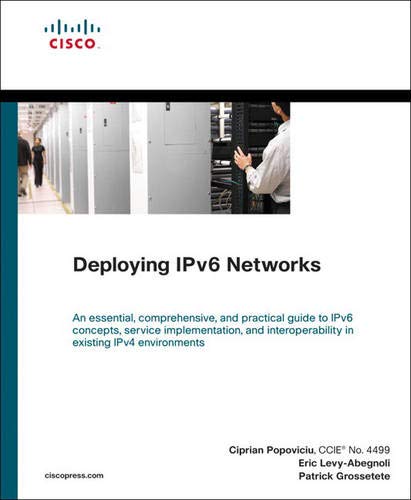Deploying IPv6 Networks
Deploying IPv6 Networks
 |
Deploying IPv6 Networks
IPv6 scales up to support new services that require a very large addressing space it is positioned to provide the infrastructure for a world where mobile devices, home appliances, and phones will each have their own, unique IP address. In the United States, major Enterprise customers interfacing with the Department of Defense, contractors such as Boeing and Lockheed Martin, have expressed stronger interest in the technology due to their customer requests. Microsoft considers IPv6 a strategic technology because it will free the networks of NATs opening the door to peer-to-peer applications. Deploying IPv6 Networks will present the service capabilities of IPv6, the features supporting these services, and the ways in which they can be implemented in a scalable, production-level network. The information will be presented in the context of the existing IPv4 operational and design concepts, anchoring the discussion to familiar ground and the environments that will be incorporating the IPv6 services. After completing Deploying IPv6 Networks the reader will Understand the state of IPv6 technologies and services and the IPv6 features as they are applied in service deployments. In addition they will know how to design and implement an IPv6 production-level network, using the book's templates and examples. Have the ability to configure and troubleshoot IPv6 in production networks and know where IPv6 developments are moving in the future.
CLICK HERE ANOTHER BOOKS CLICK HERE READ OR DOWNLOAD
Deploying IPv6 Networks
IPv6 scales up to support new services that require a very large addressing space it is positioned to provide the infrastructure for a world where mobile devices, home appliances, and phones will each have their own, unique IP address. In the United States, major Enterprise customers interfacing with the Department of Defense, contractors such as Boeing and Lockheed Martin, have expressed stronger interest in the technology due to their customer requests. Microsoft considers IPv6 a strategic technology because it will free the networks of NATs opening the door to peer-to-peer applications. Deploying IPv6 Networks will present the service capabilities of IPv6, the features supporting these services, and the ways in which they can be implemented in a scalable, production-level network. The information will be presented in the context of the existing IPv4 operational and design concepts, anchoring the discussion to familiar ground and the environments that will be incorporating the IPv6 services. After completing Deploying IPv6 Networks the reader will Understand the state of IPv6 technologies and services and the IPv6 features as they are applied in service deployments. In addition they will know how to design and implement an IPv6 production-level network, using the book's templates and examples. Have the ability to configure and troubleshoot IPv6 in production networks and know where IPv6 developments are moving in the future.
IPv6 scales up to support new services that require a very large addressing space it is positioned to provide the infrastructure for a world where mobile devices, home appliances, and phones will each have their own, unique IP address. In the United States, major Enterprise customers interfacing with the Department of Defense, contractors such as Boeing and Lockheed Martin, have expressed stronger interest in the technology due to their customer requests. Microsoft considers IPv6 a strategic technology because it will free the networks of NATs opening the door to peer-to-peer applications. Deploying IPv6 Networks will present the service capabilities of IPv6, the features supporting these services, and the ways in which they can be implemented in a scalable, production-level network. The information will be presented in the context of the existing IPv4 operational and design concepts, anchoring the discussion to familiar ground and the environments that will be incorporating the IPv6 services. After completing Deploying IPv6 Networks the reader will Understand the state of IPv6 technologies and services and the IPv6 features as they are applied in service deployments. In addition they will know how to design and implement an IPv6 production-level network, using the book's templates and examples. Have the ability to configure and troubleshoot IPv6 in production networks and know where IPv6 developments are moving in the future.


Komentar
Posting Komentar